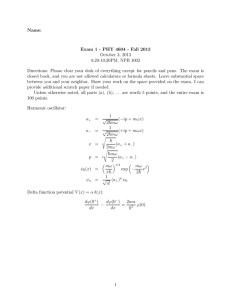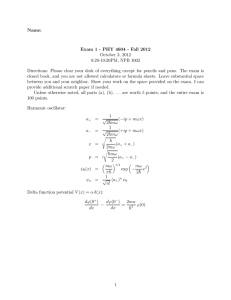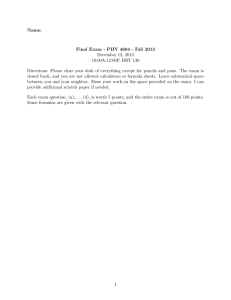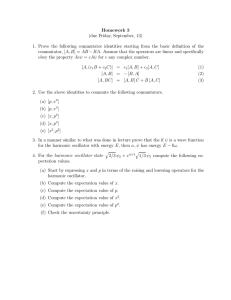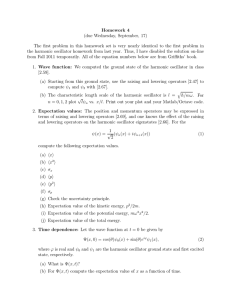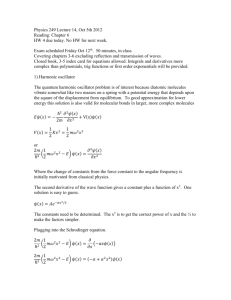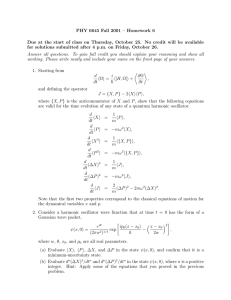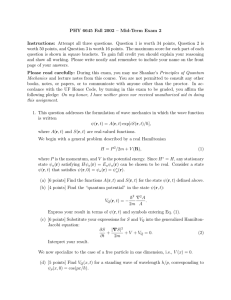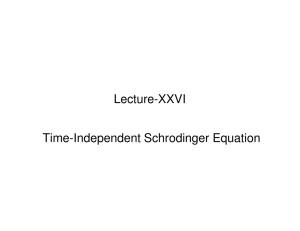Name: Exam 1 - PHY 4604 - Fall 2011 October 5, 2011
advertisement
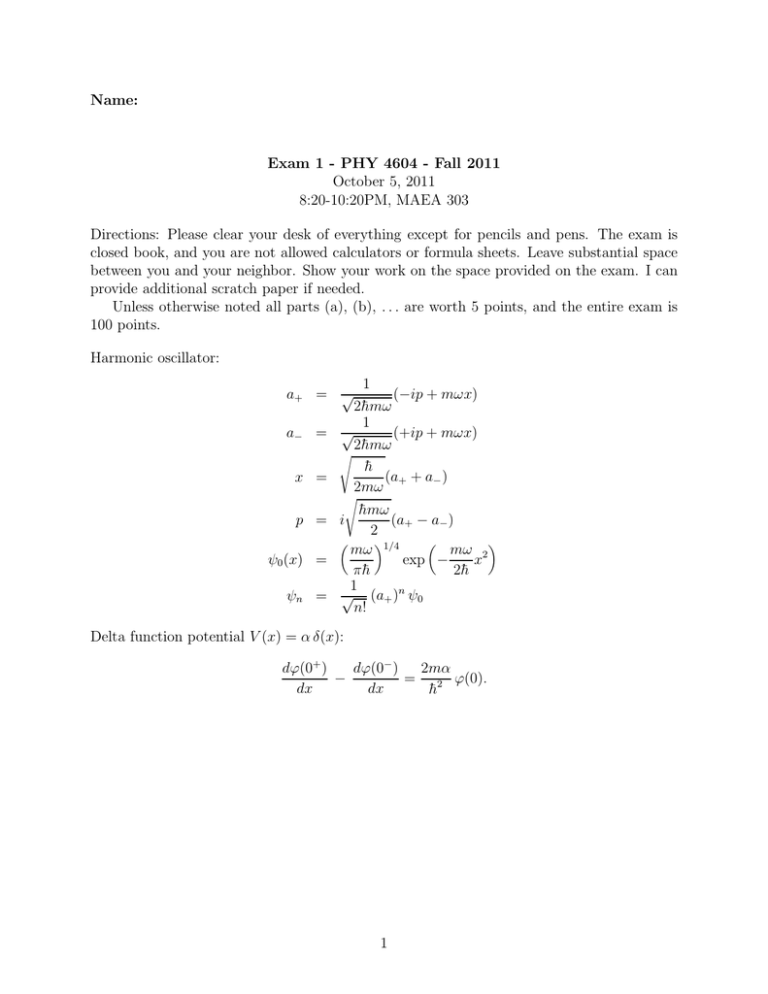
Name: Exam 1 - PHY 4604 - Fall 2011 October 5, 2011 8:20-10:20PM, MAEA 303 Directions: Please clear your desk of everything except for pencils and pens. The exam is closed book, and you are not allowed calculators or formula sheets. Leave substantial space between you and your neighbor. Show your work on the space provided on the exam. I can provide additional scratch paper if needed. Unless otherwise noted all parts (a), (b), . . . are worth 5 points, and the entire exam is 100 points. Harmonic oscillator: 1 (−ip + mωx) 2h̄mω 1 a− = √ (+ip + mωx) 2h̄mω s h̄ (a+ + a− ) x = 2mω a+ = √ s h̄mω (a+ − a− ) 2 mω 1/4 mω 2 ψ0 (x) = x exp − πh̄ 2h̄ 1 ψn = √ (a+ )n ψ0 n! p = i Delta function potential V (x) = α δ(x): dϕ(0+ ) dϕ(0− ) 2mα − = 2 ϕ(0). dx dx h̄ 1 1. Short answer section (a) Write down the time dependent Schrodinger equation in one dimension. (b) What is the physical meaning of |ψ(x, t)|2 ? (c) Give an expression for the probability current. (d) If the wave function at time t is given in terms of the eigenstates of the time independent Schrodinger equation as ψ(x, t) = X cn φn (x)e−iEn t/h̄ , n what are the cn in terms of ψ(x, 0)? (e) For a free particle (V = 0), give the wave function at time t in terms of its fourier transform at t = 0, φ(k), where Z ∞ 1 φ(k) = √ ψ(x, 0)e−ikx dx. 2π −∞ 2 2. General properties At t = 0 the wave function of a particle in an infinite square well between x = −1 and x = +1 is (Note: −1 < x < 1 not 0 < x < 1.) ψ(x, 0) = C (1 − x2 ). (1) (a) What is the constant C so that the wave function is normalized? (b) Compute the expectation values hxi, hx2 i, as well as σx for ψ(x, 0). You may use the symmetry in the problem. 3 (c) Compute the expectation values hpi, hp2 i, as well as σp for ψ(x, 0). (d) Use the results of (b) and (c) above to check that the uncertainty principle is satisfied. (e) How is the expectation value hxpi related to the expectation value hpxi? 4 3. Harmonic oscillator At t = 0 the wave function of a particle in a harmonic oscillator potential is given by ψ(x, 0) = 3 4 ψ1 (x) + i ψ2 (x). 5 5 (a) What is ψ(x, t)? (b) What is the expectation value of the momentum for ψ(x, t)? 5 . (c) What is the expectation value of the position for ψ(x, t) and how is it related to the momentum of part (b)? 6 (d) What is the expectation value of the energy for ψ(x, t)? (e) Construct a normalized harmonic oscillator state which has an expectation value of the energy of (3/4)h̄ω. This is not related to ψ in parts (a)-(d). 7 4. Piecewise constant and delta function potentials For this problem consider the one dimensional time independent Schrodinger question with potential V (x): V (x) V1 (x) V1 (x) V2 (x) = = = = V1 (x) + V2 (x) 0 for x < 0 Vo for 0 < x with Vo > 0 αδ(x). In other words, this is the step potential with a delta function potential at the interface. Assume that E > Vo . (a) For E > Vo , what is the general form of the solution for x > 0 and for x < 0. Make sure to define all variables that you introduce. (b) What is the boundary condition at x = 0 expressed in terms of your wave functions from part (a)? (c) For an incoming wave coming from the left and going to the right, which of the terms in part (a) is zero? 8 (d) (10 points) Solve for the transmission probability for a wave coming from the left and going to the right. 9
